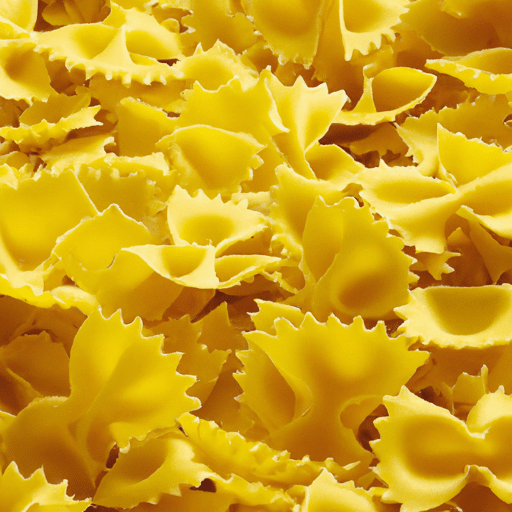Farfalle Pasta: A Delightful Delicacy on Your Plate
Have you ever come across those charming bow-tie-shaped pasta pieces? They are called “farfalle,” and they are as delightful to eat as they are to behold. With their distinctive shape and versatility, farfalle pasta is a favorite in kitchens around the world. In this blog post, we will dive into the world of farfalle pasta, exploring its taste, common uses in cooking, nutritional value, and uncovering some interesting history and facts along the way.
Visual Appeal and Taste
Farfalle, which means “butterflies” in Italian, are small rectangular or oval pieces of pasta with pinched middles, resembling adorable bow ties. Its unique shape holds sauces and ingredients beautifully and adds a touch of elegance to any dish. As for the taste, farfalle pasta has a refined, delicate flavor, almost neutral, allowing it to harmonize perfectly with a wide range of ingredients.
Common Uses in Cooking
The versatility of farfalle pasta makes it an excellent choice for an array of dishes. Whether you’re indulging in a creamy sauce, luscious pesto, or a simple olive oil and garlic toss, farfalle effortlessly adapts, enhancing the overall experience. Its compact shape and lightness make it a pleasant foundation for both warm and cold pasta salads. Furthermore, farfalle plays well with a variety of proteins, vegetables, and herbs, giving you endless possibilities for culinary exploration.
Nutritional Value
Looking to balance health and indulgence? Farfalle pasta can be a part of your well-rounded diet. Here’s a snapshot of its nutritional composition:
- Carbohydrates: Farfalle provides a good source of energy due to its carbohydrate content, making it an ideal choice for active individuals.
- Protein: While farfalle pasta is not particularly high in protein, it can be complemented with protein-rich ingredients, creating a balanced meal.
- Fiber: As with most types of pasta, farfalle contains a fair amount of dietary fiber, aiding in digestion and promoting a feeling of fullness.
- Vitamins and Minerals: Farfalle pasta contains essential B-vitamins and minerals like iron and selenium in moderate amounts.
Remember, balance is key. Pairing farfalle pasta with a range of nutritious ingredients ensures you receive a well-rounded meal that satisfies both your taste buds and nutritional needs.
A Brief History and Interesting Facts
The history of farfalle traces back to the Lombardy and Emilia-Romagna regions of Northern Italy. While the exact origin is debated, it is widely believed that farfalle pasta was inspired by the frilly collars worn by aristocratic gentlemen in the 16th century. These unique shapes eventually made their way into regional Italian cuisine, capturing the hearts of food lovers worldwide.
As a fun fact, farfalle pasta is sometimes referred to as “bow tie pasta” in English-speaking countries due to its distinctive shape. However, the true Italian name, farfalle, evokes a sense of whimsy and elegance that perfectly matches its appearance.
Cooking Farfalle Pasta to Al Dente Perfection
To enjoy the full potential of farfalle pasta, it’s crucial to achieve that perfect al dente texture. Here are some simple steps to guide you:
- Fill a pot with a generous amount of water, allowing enough space for the pasta to absorb.
- Bring the water to a rolling boil and add salt, enhancing the flavor of the pasta.
- Add farfalle pasta to the boiling water and gently stir to prevent sticking.
- Follow the package instructions for cooking time, but check for doneness a minute or two earlier. Al dente pasta should be cooked, yet firm to the bite.
- Once cooked, drain the pasta promptly and rinse with a splash of cold water to halt the cooking process.
- Serve promptly with your preferred sauce or ingredients, allowing the farfalle to shine in all its bow-tie glory.
Embrace the Elegance of Farfalle Pasta
Farfalle pasta brings elegance and versatility to your plate, making it a wonderful addition to any mealtime. Whether you dress it in a classic tomato sauce or toss it with vibrant vegetables, each bite captivates with a comforting and satisfying taste. So, why not embark on a culinary journey with this whimsical pasta and let your creativity take flight?
Farfalle Pasta
Origin: Farfalle, also known as bow tie pasta, originated in Northern Italy. Its name, “farfalle,” means butterflies in Italian and it is shaped to resemble these delicate creatures.
Common Uses: Farfalle is a versatile pasta that works well with a variety of sauces. It is commonly used in pasta salads, baked pasta dishes, and creamy sauces. Its unique shape allows it to hold sauce well, making it a popular choice for many recipes.
Nutritional Benefits: Farfalle pasta is mainly made from durum wheat semolina, which is a good source of carbohydrates, providing the necessary energy for the body. It also contains small amounts of protein and fiber. The specific nutritional values may vary depending on the brand and the ingredients used.
Unique Properties: Farfalle pasta stands out due to its distinctive bow tie shape. The shape of the pasta not only lends itself to creative and visually appealing presentations but also promotes even cooking. The ridges and folds in the pasta catch and hold onto sauce, allowing it to coat the pasta effectively.
Historical Significance: The origin of farfalle pasta can be traced back to the Emilia-Romagna region of Northern Italy. It has been a part of Italian cuisine for centuries and holds cultural and historical significance. Over time, it has gained popularity worldwide and is now enjoyed in various countries as a versatile and visually appealing pasta shape.
Farfalle pasta’s origin in Italy, its common uses, nutritional benefits, unique properties, and historical significance make it an interesting and well-loved ingredient in the culinary world.




Use the share button below if you liked it.
It makes me smile, when I see it.